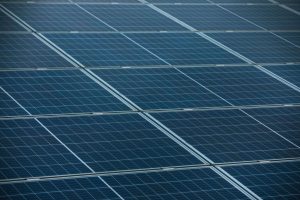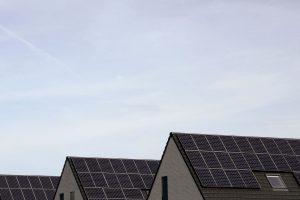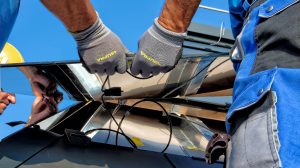
In fact, cold temperatures can actually improve the efficiency of solar panels by reducing resistance in the electrical circuits, leading to a slight increase in power output.
Energy Storage Provides Stability
To ensure a stable and reliable energy supply during the winter season, many solar energy systems incorporate energy storage solutions such as batteries. Energy storage allows homeowners and businesses to store excess energy generated during sunny periods and use it later when sunlight is scarce or grid power is unavailable. By coupling solar panels with energy storage, solar energy systems can provide uninterrupted power year-round, even during winter storms and extended periods of low sunlight.
Long-Term Benefits Outweigh Seasonal Variations
While it’s true that solar energy production may fluctuate seasonally, the long-term benefits of solar power far outweigh any temporary reductions in output during the winter months. Solar energy systems continue to generate electricity and offset utility bills year-round, helping homeowners and businesses save money, reduce their carbon footprint, and contribute to a more sustainable energy future.
Conclusion: Solar Energy Shines Through Winter
In conclusion, solar energy remains a reliable and effective energy source throughout the winter season. While factors such as reduced daylight hours, inclement weather, and snow cover may temporarily affect solar panel performance, clear skies, proper tilt and orientation, and energy storage solutions can mitigate these challenges and ensure a stable energy supply year-round. By harnessing the power of the sun, homeowners and businesses can enjoy the benefits of clean, renewable energy regardless of the season, making solar energy a shining solution for a brighter, more sustainable future.
As concerns about climate change and energy consumption continue to rise, growers are turning to innovative solutions to cultivate food sustainably.
Harnessing Solar Energy for Sustainable Agriculture
Solar-powered greenhouses utilize solar energy to create a self-sustaining ecosystem for growing plants. The greenhouse structure is equipped with solar panels that capture sunlight and convert it into electricity to power various components of the greenhouse, such as lighting, heating, ventilation, and irrigation systems. By harnessing the sun’s energy, growers can reduce reliance on fossil fuels and minimize greenhouse gas emissions associated with traditional greenhouse operations.
Creating an Ideal Growing Environment
Solar-powered greenhouses provide growers with greater control over environmental factors such as temperature, humidity, and light levels, creating an ideal growing environment for a wide range of crops. Advanced climate control systems regulate temperature and humidity levels, ensuring optimal growing conditions year-round. Additionally, supplemental lighting powered by solar energy extends the growing season and allows growers to cultivate crops even in low-light conditions.
Maximizing Energy Efficiency and Sustainability
One of the key advantages of solar-powered greenhouses is their energy efficiency and sustainability. By using renewable solar energy to power greenhouse operations, growers can significantly reduce energy costs and minimize their carbon footprint. Energy-efficient technologies such as insulated glazing, thermal curtains, and automated ventilation systems further enhance energy efficiency and help maintain stable growing conditions while minimizing energy consumption.

In an era of changing climate patterns and global food insecurity, solar-powered greenhouses play a crucial role in promoting food security and resilience.
Enhancing Crop Yields and Quality
Solar-powered greenhouses offer numerous benefits for crop production, including increased yields and improved crop quality. By providing a controlled environment free from pests, diseases, and adverse weather conditions, growers can optimize crop growth and productivity. Additionally, the ability to regulate light levels and photoperiods allows growers to manipulate plant growth and flowering cycles, leading to higher yields and better-quality crops.
Promoting Food Security and Resilience
In an era of changing climate patterns and global food insecurity, solar-powered greenhouses play a crucial role in promoting food security and resilience. By providing a reliable and sustainable source of fresh produce year-round, solar-powered greenhouses help communities access nutritious food regardless of seasonal variations or external factors. Additionally, decentralized greenhouse operations reduce reliance on long-distance food transportation and support local food systems.
Conclusion: Cultivating a Greener Future with Solar-Powered Greenhouses
In conclusion, solar-powered greenhouses represent a significant advancement in sustainable agriculture, harnessing the power of the sun to create an ideal growing environment while minimizing environmental impact. By combining renewable solar energy with advanced greenhouse technologies, growers can maximize energy efficiency, enhance crop yields and quality, and promote food security and resilience in their communities. As we continue to embrace innovative solutions for sustainable food production, solar-powered greenhouses offer a promising pathway to a greener and more resilient future for agriculture.
As communities worldwide grapple with the devastating impacts of hurricanes, wildfires, floods, and other extreme weather events, renewable energy emerges as a powerful tool for ensuring continuity in times of crisis.
Reliable and Decentralized Power Sources
Renewable energy sources such as solar, wind, and hydropower offer reliable and decentralized alternatives to centralized power grids, which are vulnerable to damage and disruption during disasters. By harnessing the abundant and freely available energy from the sun, wind, and water, communities can generate electricity locally and independently, reducing reliance on external power sources and minimizing the risk of power outages during emergencies.
Off-Grid Solutions for Remote and Vulnerable Areas
In remote and vulnerable areas with limited access to traditional energy infrastructure, renewable energy provides off-grid solutions that enhance resilience and self-sufficiency. Solar microgrids, small-scale wind turbines, and mini-hydroelectric systems can provide reliable power to off-grid communities, enabling essential services such as healthcare facilities, schools, and communication networks to function even in the aftermath of disasters.
Rapid Deployment and Scalability
Renewable energy technologies are characterized by their rapid deployment and scalability, making them ideal solutions for disaster response and recovery efforts. Solar panels and wind turbines can be quickly installed in disaster-affected areas to provide immediate power generation, while energy storage systems such as batteries and fuel cells enable the storage and distribution of excess energy for use during emergencies.
Resilient Infrastructure and Energy Systems
Renewable energy infrastructure is inherently more resilient and robust than traditional fossil fuel infrastructure, which is susceptible to damage from extreme weather events and natural disasters. Solar panels, wind turbines, and hydropower facilities are designed to withstand harsh environmental conditions and continue operating even in the face of adversity, ensuring the resilience and reliability of energy systems when they are needed most.

In remote and vulnerable areas with limited access to traditional energy infrastructure, renewable energy provides off-grid solutions that enhance resilience and self-sufficiency.
Climate Mitigation and Adaptation
By reducing greenhouse gas emissions and mitigating climate change, renewable energy contributes to long-term resilience and adaptation efforts. Transitioning to renewable energy sources helps mitigate the frequency and intensity of extreme weather events, reducing the risk of future disasters and enhancing community resilience in the face of a changing climate.
Empowering Communities and Building Social Capital
Renewable energy projects empower communities to take control of their energy future and build social capital through collaborative decision-making and collective action. Community-owned renewable energy initiatives foster resilience by promoting local ownership, economic development, and social cohesion, strengthening community bonds and fostering a sense of shared responsibility for disaster preparedness and response.
Conclusion: Harnessing the Power of Renewables for Resilience
In conclusion, renewable energy holds immense value in disaster resilience, offering reliable, decentralized, and sustainable solutions to the challenges posed by climate-related disasters. By investing in renewable energy infrastructure, communities can enhance their resilience, protect against the impacts of extreme weather events, and build a more sustainable and secure future for generations to come. As we confront the growing threats of climate change, renewable energy emerges as a beacon of hope, empowering communities to weather the storm and emerge stronger and more resilient than ever before.
As cities continue to grow and expand, the demand for energy rises in tandem. However, with the looming specter of climate change, traditional energy sources no longer suffice. This is where renewable energy steps in to reshape the urban fabric for the better.
Solar Solutions
One of the most prominent forms of renewable energy, solar power, presents a myriad of opportunities for urban areas. From rooftop solar panels on residential buildings to vast solar arrays in city outskirts, harnessing the sun’s energy can significantly reduce reliance on conventional power grids. Innovative designs even allow for solar panels to be integrated seamlessly into building facades, blending sustainability with architectural aesthetics.
Wind Energy in Urban Spaces
Despite the perception of cities as windless landscapes, urban environments can harness the power of the wind. Vertical axis wind turbines, designed to capture wind from any direction, offer a space-efficient solution for densely populated areas. By strategically placing wind turbines in urban spaces, cities can generate clean electricity while minimizing their carbon footprint.

Embracing green building practices not only mitigates the environmental impact of urban development but also enhances the quality of life for residents.
Green Building Practices
In addition to energy generation, sustainable urban design encompasses energy-efficient building practices. Green building features such as passive solar design, natural ventilation systems, and high-performance insulation reduce energy consumption and promote environmental stewardship. Embracing green building practices not only mitigates the environmental impact of urban development but also enhances the quality of life for residents.
Benefits for Urban Communities
The integration of renewable energy into urban design brings forth a host of benefits:
- Environmental Sustainability: Reducing greenhouse gas emissions and reliance on fossil fuels mitigates the impact of climate change and preserves natural resources.
- Energy Independence: Diversifying energy sources enhances energy security and reduces vulnerability to supply disruptions.
- Economic Opportunities: Investing in renewable energy infrastructure stimulates job creation, fosters innovation, and attracts sustainable development opportunities.
- Resilience: Decentralized renewable energy systems enhance the resilience of urban communities by providing reliable power sources during emergencies or grid failures.
Conclusion: Paving the Way Forward
As we stand at the nexus of urbanization and environmental stewardship, the integration of renewable energy into urban design represents a pivotal step towards a sustainable future. By embracing clean energy solutions, cities can mitigate their environmental impact, enhance energy security, and foster resilient, livable communities for generations to come. In the journey towards sustainable urbanization, renewable energy serves as a beacon of hope, illuminating the path towards a brighter, greener tomorrow.
In today’s housing market, homeowners are increasingly turning to solar energy not only to reduce their carbon footprint but also to enhance the value of their properties.
Increased Home Value
One of the most significant benefits of installing solar panels is the boost they provide to your home’s resale value. Numerous studies have shown that homes equipped with solar panels tend to sell for more money and faster than comparable homes without solar. According to a study by the Lawrence Berkeley National Laboratory, solar homes typically command a premium of around $15,000 compared to non-solar homes.
Energy Cost Savings
In addition to increasing your home’s value, solar panels offer significant energy cost savings that appeal to prospective buyers. By generating electricity from the sun, solar panels reduce or eliminate your reliance on grid electricity, resulting in lower utility bills over the long term. Homebuyers are increasingly attracted to homes with solar panels because they recognize the potential for ongoing energy savings and reduced operating costs.
Renewable Energy Incentives
Government incentives and rebates further enhance the value proposition of solar panels for homeowners. Federal tax credits, state and local incentives, and utility rebate programs can significantly reduce the upfront cost of installing solar panels, making them a more attractive investment for homeowners. These incentives not only make solar panels more affordable but also increase their perceived value in the eyes of potential buyers.

Environmental Stewardship
Beyond financial considerations, solar panels appeal to homebuyers who value environmental sustainability and want to reduce their carbon footprint. By generating clean, renewable energy from the sun, solar panels help homeowners shrink their environmental impact and contribute to the fight against climate change. Properties equipped with solar panels are seen as eco-friendly and forward-thinking, which can further enhance their appeal to environmentally conscious buyers.
Marketing Advantage
Having solar panels installed on your home can give you a competitive edge in the real estate market. Listings that highlight solar panels as a feature often attract more attention from potential buyers, leading to increased interest and higher offers. Additionally, studies have shown that homes with solar panels tend to spend less time on the market, as buyers recognize the value and benefits of solar energy.
Conclusion: A Brighter Future for Your Home
In conclusion, solar panels offer numerous benefits that can significantly enhance the value of your home. From increased resale value and energy cost savings to environmental stewardship and marketing advantages, solar panels are a wise investment that pays dividends both now and in the future. By harnessing the power of the sun, you’re not just boosting the value of your home—you’re also investing in a cleaner, brighter future for yourself and generations to come.
Before you embark on your journey to go green, it’s essential to consider several unique factors that can impact the success and effectiveness of your renewable energy investment.
Energy Needs and Consumption
Before investing in renewable energy, it’s crucial to assess your current energy needs and consumption patterns. Understanding how much energy your home or business uses on a daily, monthly, and annual basis will help you determine the size and type of renewable energy system that best suits your needs. Consider factors such as peak demand times, seasonal variations, and future growth projections when evaluating your energy requirements.
Site Assessment and Feasibility
The feasibility of renewable energy installation depends largely on your site’s characteristics, such as location, orientation, shading, and available space. Conducting a thorough site assessment will help you determine the suitability of your property for renewable energy technologies such as solar panels, wind turbines, or geothermal systems. Factors such as roof condition, terrain, and local climate conditions can also impact the feasibility and performance of renewable energy systems.
Financial Considerations
Investing in renewable energy involves upfront costs that may require careful financial planning and consideration. Evaluate your budget, financing options, and available incentives such as tax credits, rebates, and financing programs to determine the financial feasibility of your renewable energy investment. Consider factors such as return on investment (ROI), payback period, and long-term savings when assessing the financial benefits of renewable energy.
Regulatory and Permitting Requirements
Navigating the regulatory landscape and obtaining the necessary permits for renewable energy installation can be a complex process. Familiarize yourself with local zoning regulations, building codes, utility interconnection requirements, and environmental permitting processes to ensure compliance with all applicable laws and regulations. Engage with local authorities, utility providers, and renewable energy professionals to streamline the permitting process and avoid potential delays or setbacks.

Understanding how much energy your home or business uses on a daily, monthly, and annual basis will help you determine the size and type of renewable energy system that best suits your needs.
Maintenance and Operations
While renewable energy systems generally require minimal maintenance compared to traditional energy sources, it’s essential to consider ongoing maintenance and operational requirements when investing in renewable energy. Determine who will be responsible for system maintenance, monitoring, and troubleshooting, and budget accordingly for any necessary upkeep or repairs. Educate yourself on best practices for system operation and maintenance to maximize the lifespan and performance of your renewable energy investment.
Environmental and Social Impact
Renewable energy offers numerous environmental and social benefits, including reduced greenhouse gas emissions, improved air quality, and job creation. Consider the environmental and social impact of your renewable energy investment, including potential benefits and any associated risks or trade-offs. Engage with stakeholders, community members, and environmental organizations to ensure that your renewable energy project aligns with sustainability goals and values.
Conclusion: Making Informed Decisions for a Sustainable Future
In conclusion, investing in renewable energy requires careful consideration of various factors to ensure a successful and effective outcome. By assessing your energy needs, conducting a site assessment, evaluating financial considerations, navigating regulatory requirements, planning for maintenance and operations, and considering environmental and social impact, you can make informed decisions that align with your goals and values for a sustainable future. Whether you’re a homeowner, business owner, or investor, renewable energy offers a pathway to cleaner, more resilient, and more sustainable energy solutions that benefit both you and the planet.
As outdoor enthusiasts seek to connect with nature while minimizing their environmental impact, the concept of solar-powered camping has gained popularity.
Understanding Solar-Powered Camping
At its core, solar-powered camping involves using solar energy to meet various energy needs while camping, such as charging electronic devices, powering lights, and running small appliances. Portable solar panels and solar-powered generators serve as the primary means of capturing and storing solar energy, allowing campers to enjoy modern comforts without relying on grid electricity or noisy generators.
Essential Solar Gear for Camping
To embark on a successful solar-powered camping adventure, it’s essential to have the right gear. Here are some essential solar-powered camping items to consider:
- Portable Solar Panels: Compact and lightweight solar panels designed for camping can be easily set up to capture sunlight and convert it into electricity to charge devices or power camping gear.
- Solar-Powered Lanterns and Lights: Solar-powered lanterns and string lights provide illumination at night without the need for batteries or fuel, creating a cozy and eco-friendly ambiance at the campsite.
- Solar-Powered Chargers: Solar-powered chargers for smartphones, tablets, and other electronic devices allow campers to stay connected and powered up even in remote locations, ensuring safety and convenience during outdoor adventures.

Solar-powered camping is not just about energy efficiency; it’s also about embracing sustainability and minimizing environmental impact.
Tips for Maximizing Solar Energy
To make the most of solar-powered camping, consider the following tips for maximizing solar energy efficiency:
- Choose the Right Location: Set up your solar panels in a location with maximum sunlight exposure, such as an open clearing or a south-facing slope, to capture as much sunlight as possible throughout the day.
- Angle Your Solar Panels: Adjust the angle of your solar panels throughout the day to track the sun’s movement and optimize solar energy capture. Tilting the panels towards the sun can significantly increase energy production, especially during early morning and late afternoon hours.
- Monitor Energy Consumption: Be mindful of your energy consumption and prioritize essential devices to conserve power and extend battery life. Turn off or unplug unnecessary electronics when not in use to minimize energy drain and maximize available power.
Embracing Sustainability in the Outdoors
Solar-powered camping is not just about energy efficiency; it’s also about embracing sustainability and minimizing environmental impact. By choosing solar-powered camping gear and reducing reliance on fossil fuels, campers can tread lightly on the earth while enjoying the beauty of the natural world. Leave-no-trace principles, sustainable camping practices, and environmental stewardship are integral to the ethos of solar-powered camping.
Planning Your Solar-Powered Adventure
Before embarking on a solar-powered camping trip, it’s essential to plan ahead and prepare accordingly. Research camping destinations that are conducive to solar energy capture, check weather forecasts, and assess your energy needs to determine the size and type of solar gear required. Pack essentials such as solar panels, chargers, lights, and batteries, and familiarize yourself with how to set up and use solar-powered equipment before hitting the trail.
Conclusion: Embrace the Power of the Sun
In conclusion, solar-powered camping offers outdoor enthusiasts a sustainable and eco-friendly way to enjoy the beauty of nature while staying powered up and connected. By harnessing the power of the sun, campers can embark on off-grid adventures with confidence, knowing that they’re reducing their environmental footprint and embracing a more sustainable way of life. Whether you’re a seasoned camper or a novice explorer, consider incorporating solar-powered camping gear into your outdoor adventures and embrace the power of the sun on your next camping trip.
Although each provider might have a different process, most solar companies generally follow these basic steps when installing a solar system.
1. Initial Consultation and Site Assessment
The journey begins with an initial consultation with a reputable solar installer. During this consultation, the installer will assess your home’s energy needs, evaluate your roof’s suitability for solar panels, and discuss your goals and preferences for the solar energy system. They may also provide a preliminary estimate of the system size, cost, and potential energy savings.
2. Design and Proposal
Based on the information gathered during the initial consultation, the solar installer will design a customized solar energy system tailored to your home’s specific requirements. This design will take into account factors such as roof orientation, tilt, shading, and available space for solar panels. Once the design is finalized, the installer will provide you with a detailed proposal outlining the system specifications, cost breakdown, financing options, and projected energy savings.
3. Permitting and Paperwork
Before installation can begin, the solar installer will handle the necessary permitting and paperwork on your behalf. This may include obtaining permits from local authorities, submitting interconnection agreements with the utility company, and completing any paperwork required for incentive programs or rebates. The installer will ensure that all necessary approvals are obtained before proceeding with the installation.

Installation Day
With permits in hand and paperwork finalized, installation day finally arrives. The installation process typically begins with preparing the roof and mounting the racking system that will support the solar panels. Next, the solar panels themselves are installed on the racking system, securely fastened to withstand wind, snow, and other weather conditions. Finally, the electrical components, such as inverters and wiring, are connected to integrate the solar energy system with your home’s electrical system.
Inspection and Activation
Once the installation is complete, a final inspection will be conducted to ensure that the solar energy system meets all applicable building codes and safety standards. After passing inspection, the utility company will install a bi-directional meter to measure the electricity generated by your solar panels and any excess energy exported to the grid. With the meter in place and the system activated, you can begin enjoying the benefits of clean, renewable solar energy.
Ongoing Maintenance and Monitoring
After installation, the solar energy system will require minimal maintenance to ensure optimal performance. Most solar panels are self-cleaning, but periodic inspections and cleanings may be recommended to remove dirt, dust, or debris that could affect energy production. Additionally, many solar installers offer monitoring services to track your system’s performance remotely and identify any issues that may arise, ensuring that your solar investment continues to deliver long-term value.
**Conclusion: Powering Your Home with Solar Energy**
In conclusion, the installation process for residential solar is a well-coordinated journey that begins with an initial consultation and ends with the activation of your solar energy system. With the expertise of a reputable solar installer guiding you every step of the way, you can rest assured that your transition to solar power will be smooth, seamless, and ultimately rewarding. By harnessing the power of the sun, you’re not just powering your home—you’re contributing to a cleaner, brighter future for generations to come.
In our collective journey towards a sustainable future, solar energy has emerged as a transformative force with the power to not only generate electricity but also uplift communities in profound ways.
Economic Empowerment and Job Creation
Solar energy projects, whether large-scale installations or small rooftop systems, create jobs and stimulate economic growth at the local level. From solar panel manufacturing and installation to maintenance and support services, the solar industry offers a wide range of employment opportunities for skilled workers and entrepreneurs. By investing in solar energy, communities can attract new businesses, drive innovation, and bolster their economies for long-term prosperity.
Energy Affordability and Accessibility
For many communities, particularly those in underserved or remote areas, access to affordable and reliable energy can be a challenge. Solar energy offers a solution by providing a decentralized and scalable source of power that can be deployed quickly and cost-effectively. Community solar projects, for example, allow multiple households to share the benefits of a single solar installation, reducing energy costs and improving access to clean electricity for all residents.
Environmental Health and Resilience
By transitioning to solar energy, communities can reduce their reliance on fossil fuels and mitigate the harmful effects of air and water pollution on public health. Solar power generates electricity without producing greenhouse gas emissions or toxic pollutants, helping to improve air quality, reduce respiratory illnesses, and protect natural ecosystems. Moreover, solar energy enhances community resilience by providing a reliable and resilient source of power that can withstand extreme weather events and grid disruptions.

Community solar projects, for example, allow multiple households to share the benefits of a single solar installation
Education and Awareness
Solar energy projects serve as educational tools that raise awareness about renewable energy and inspire future generations to embrace sustainability. Schools, community centers, and local organizations can use solar installations as living laboratories to teach students and community members about the science, technology, and benefits of solar energy. By fostering a culture of environmental stewardship and innovation, communities can empower individuals to become agents of change in the transition to a clean energy future.
Social Equity and Empowerment
Solar energy has the potential to promote social equity and empower marginalized communities by democratizing energy production and distribution. Community-owned solar projects, for example, allow residents to collectively own and benefit from solar installations, reducing energy costs and creating opportunities for economic empowerment. Moreover, initiatives that prioritize solar access for low-income households and communities of color help to address energy inequities and bridge the gap between energy haves and have-nots.
Conclusion: A Brighter Future for All
In conclusion, the benefits of solar energy extend far beyond its ability to generate electricity; they encompass economic empowerment, environmental health, education, and social equity. By harnessing the power of the sun, communities can build a brighter and more resilient future for all residents, while also contributing to the global effort to combat climate change. As we continue to embrace the promise of solar energy, let us work together to harness its transformative potential and create thriving, sustainable communities for generations to come.
By addressing these common questions and concerns, we hope to empower homeowners like you to make informed decisions about embracing solar energy for your home.
How Does Solar Power Work for Homes?
Solar panels, typically installed on the roof, capture sunlight and convert it into electricity through photovoltaic cells. This electricity is then used to power your home’s appliances, lighting, and other electrical devices. Any excess energy generated can be stored in batteries for later use or fed back into the grid for credit.
Is My Home Suitable for Solar Panels?
Most homes are suitable for solar panel installation, provided they have a roof or area with unobstructed access to sunlight for a significant portion of the day. Factors such as roof orientation, tilt, shading from trees or nearby buildings, and local weather patterns can affect the feasibility and efficiency of solar power generation.
How Much Does a Residential Solar System Cost?
The cost of a residential solar system varies depending on factors such as the size of the system, your location, local incentives and rebates, and the complexity of the installation. However, with falling prices for solar panels and financial incentives available in many regions, solar power has become increasingly affordable for homeowners.
What Financial Incentives and Rebates Are Available?
Depending on where you live, you may be eligible for a range of financial incentives and rebates to help offset the cost of installing solar panels. These incentives can include federal tax credits, state and local rebates, net metering programs, and financing options such as solar leases or power purchase agreements.

How Long Does It Take to Recoup the Cost of Solar Panels?
The payback period for a residential solar system depends on factors such as your energy usage, the cost of electricity in your area, the size of your system, and available financial incentives. In many cases, homeowners can recoup the upfront cost of solar panels through energy savings within 5 to 10 years, after which they can enjoy virtually free electricity for decades.
What Maintenance Is Required for Solar Panels?
Solar panels require minimal maintenance, typically limited to occasional cleaning to remove dirt, dust, and debris that may accumulate on the surface. Most reputable solar installers offer warranties and service agreements to cover any issues that may arise with your system over its lifespan, providing homeowners with peace of mind.
Will Solar Panels Increase the Value of My Home?
Studies have shown that homes equipped with solar panels tend to sell faster and at a higher price than comparable homes without solar. A solar energy system is considered a valuable asset that can increase the resale value of your home while also making it more attractive to environmentally conscious buyers.
What Environmental Benefits Does Solar Power Offer?
By generating electricity from the sun’s abundant and renewable energy, solar power helps reduce reliance on fossil fuels, lower greenhouse gas emissions, and mitigate the impacts of climate change. Switching to solar power for your home is one of the most effective ways to shrink your carbon footprint and contribute to a more sustainable future.
In Conclusion
Residential solar power offers numerous benefits, from cost savings and energy independence to environmental stewardship and increased home value. By addressing these common questions and concerns, we hope to empower homeowners like you to make informed decisions about embracing solar energy for your home. If you’re ready to take the next step towards a brighter, cleaner future, consider reaching out to a reputable solar installer in your area to explore your options further.